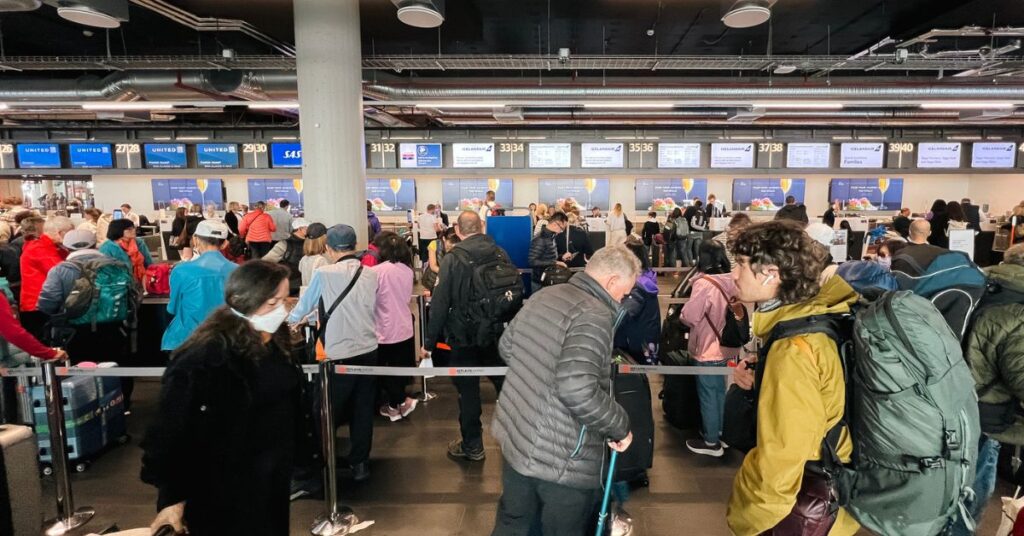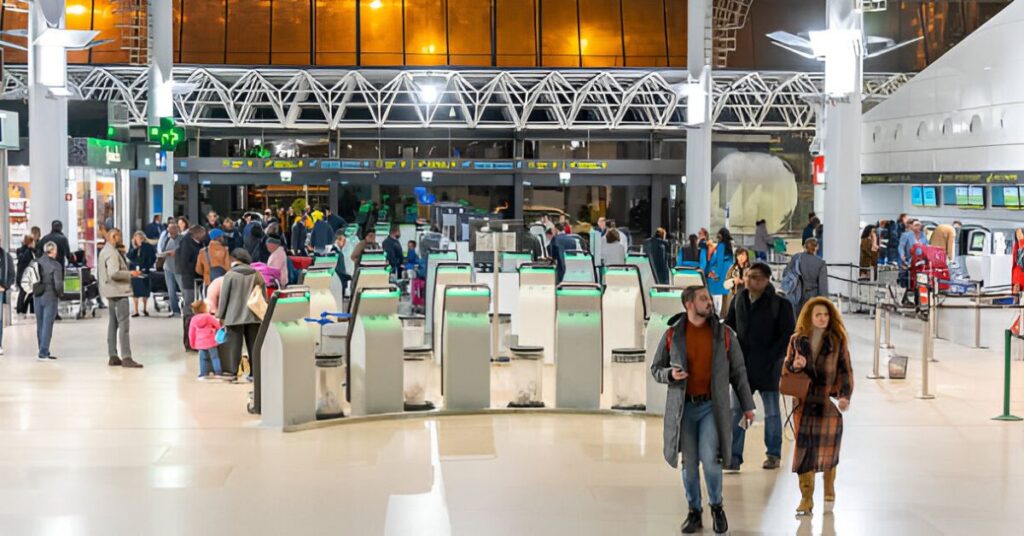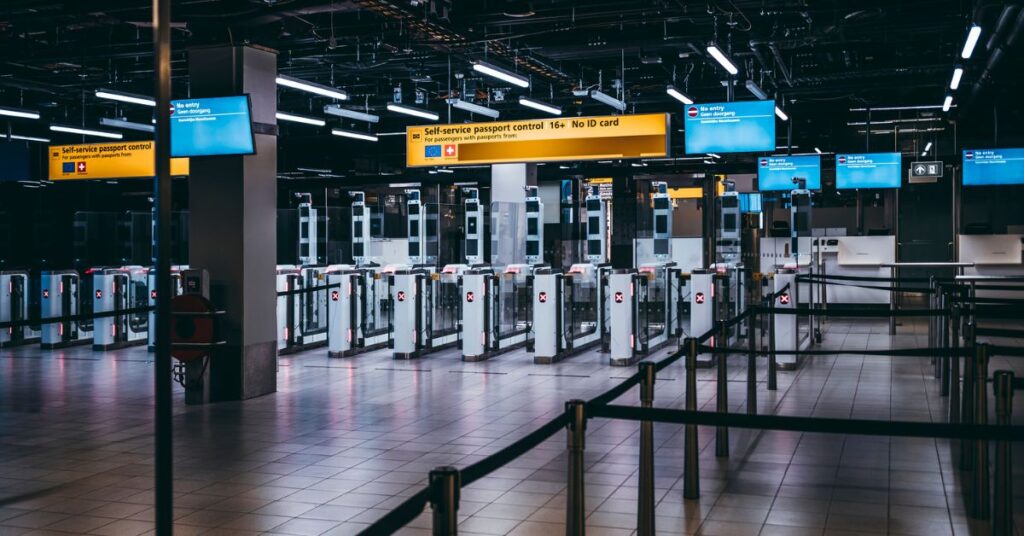EU Entry-Exit Rules Could Trigger Airport Chaos from October
Sep 4, 2025
Category: Border and Security EES EU News

Airports across Europe could face severe disruption when the European Union’s (EU) long-delayed Entry-Exit System (EES) launches on 12 October.
Aviation experts cautioned that passenger bottlenecks may lead to flight cancellations and diversions.
New border checks, biometric data
Aviation economist Oliver Ranson, who has studied flight patterns across major hubs, told The Independent that some airports may reach capacity in their arrivals halls within minutes if biometric checks slow down processing.
“It takes a surprisingly short time for an airport, which is normally working very well indeed, to completely collapse,” he said. “People simply can’t fit into the arrivals hall, so planes have to be held at the gate with passengers on board.”
The EES will apply to all non-EU nationals entering or leaving the Schengen Area. Under the scheme, travelers must register facial biometrics and fingerprints during their first trip after implementation. Children under 12 are exempt from fingerprint collection.
The Schengen Area covers most EU member states except Ireland and Cyprus, but also includes non-EU members Norway, Iceland, and Switzerland. Once in place, the system replaces manual passport stamping with digital registration of entries and exits.
Many airports, including Athens, have already installed biometric kiosks in arrival halls to capture the necessary data. However, pilot tests suggested that processing times at EES checkpoints could be up to four times longer than current border checks.
For travelers, the process will be compounded by “double red tape,” as passports must still be inspected and stamped by border officers during the 180-day roll-out phase, which ends April 9th, 2026.
Airports under pressure
Ranson’s analysis identified Athens, Bucharest, and Milan Malpensa as the airports most vulnerable to gridlock, followed closely by Budapest and Berlin. These hubs have non-Schengen arrivals evenly distributed throughout the day, leaving little time for queues to dissipate between flights.
If bottlenecks form, he warned, “maybe even some flights will have to be diverted or [canceled] because an airport can’t accommodate them.”
Other airports flagged as at risk include Vienna, Rome Fiumicino, Amsterdam, Copenhagen, and Prague.
By contrast, Palermo in Sicily was singled out as the least likely to experience significant problems, due to its “waves” of arrivals that allow staff time to clear queues before the next batch of flights.
Two of Europe’s busiest hubs, Paris Charles de Gaulle and Faro in Portugal’s Algarve, receive the highest proportion of non-Schengen arrivals.
However, Ranson noted that these airports may cope better than expected because flights are clustered at certain times of day, giving border staff windows to recover between waves.

System roll-out and contingencies
The EU initially considered launching the EES simultaneously across all Schengen borders, but has opted for a staggered approach.
Member states will progressively phase in the system, with allowances for authorities to temporarily let up to 90 percent of travelers bypass biometric checks when queues become unmanageable.
Even with these measures, Ranson cautioned that the introduction of any new border technology carries risks.
“When things do start to go wrong and when new systems like the entry-exit system are introduced, unexpected niggles can make the overall arrivals process get very gnarly very quickly,” he said.
Risks of cascading disruption
The potential for disruption extends beyond arrivals. If long queues prevent passengers from clearing border control quickly enough, planes may be forced to wait at gates, delaying departures for outgoing flights.
“Eventually, planes aren’t going to be allowed to arrive anymore,” Ranson warned. “And when planes can’t arrive anymore, or if they’re held at the gate for a long time, that means that flights going back out from the airport are [canceled].”
This could mean that even passengers who never pass through Schengen border controls—such as those on connecting or outbound flights—could face delays and cancellations if airports become saturated.

Limited capacity, staff
Airport operators and airlines have long acknowledged that arrivals halls cannot be built large enough to handle peak passenger flows without queues forming.
“They just can’t build an arrivals hall which is big enough and employ enough staff to get everybody through without waiting,” Ranson said. “But hopefully, most of the time people don’t have to queue for too long.”
The economist added that airports with a consistent flow of non-Schengen flights may be most at risk, because they lack “recovery time” between arrivals. Airports with peaks and troughs of traffic, while still challenged, are more likely to manage surges.
Extra hurdles for tourists, long-time travelers
Short-stay visitors, including tourists, will face these new checks alongside passport inspection during the initial roll-out.
For people who travel often for work or family reasons, repeated registration and queueing could make cross-border trips more time-consuming.
By late 2026, these procedures will coincide with the launch of the European Travel Information and Authorization System (ETIAS).
ETIAS will require travellers from 59 visa-exempt countries to apply online before departure, at a cost of €20, and authorization will be valid for three years or until the traveler’s passport expires.
While ETIAS is designed to speed up border screening by pre-vetting travelers, its introduction alongside biometric checks means that non-EU visitors will face two layers of requirements.
This combination is expected to enhance oversight of arrivals but may also result in longer processing times during peak travel periods.

New tools for immigration management
The roll-out of the EES gives EU states a real-time record of when non-EU nationals enter and leave, replacing the manual system of passport stamps. This change is intended to make it easier to detect overstays and to track movements across the Schengen Area.
For national authorities, the system offers a shared database that can be used to monitor irregular migration more closely.
The introduction of ETIAS will add a further stage of control. Travelers from visa-exempt countries will be screened before they arrive, with applications checked against security and migration databases.
Together, these measures expand the information available to immigration authorities and are likely to influence how border staffing and infrastructure are organized.
Officials will have to manage both the new technology and the risk of congestion in terminals, which could shape future policy on airport capacity and resources.
Preparing for change at Europe’s borders
The introduction of the EES is expected to test the limits of Europe’s busiest airports. Analysts warned that the new biometric checks could quickly overwhelm arrival halls in places such as Athens, Bucharest, and Milan Malpensa.
For travelers, the coming months will be a measure of whether the system can be integrated without major disruption, or if long waits and flight delays become part of crossing Europe’s borders.
